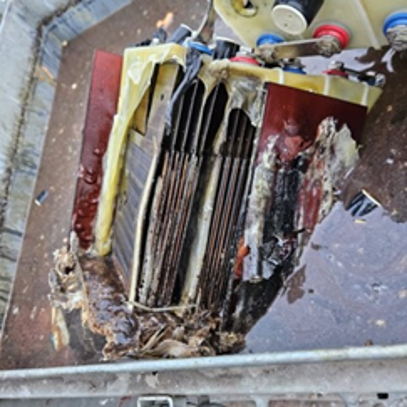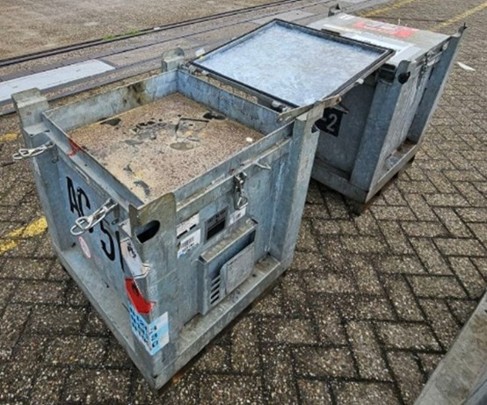Smoke in the battery room
- Safety Flash
- Published on 7 November 2025
- Generated on 22 December 2025
- IMCA SF 20/25
- 5 minute read
Jump to:
Smoke was observed in the battery room of a vessel alongside.
What happened?
Smoke was observed in the battery room of a vessel alongside. The fire detection alarm went off on the bridge. A visual check at the scene confirmed visible smoke. The general fire alarm was promptly raised, initiating an organized muster and emergency response.
The event was brought under control by the onboard firefighting teams. Ventilation to the area was controlled and the relevant electrical circuits were isolated. The source of the smoke was identified as a set of overheated Nickel-Cadmium (Ni-Cd) batteries used for one of the UPS’s (Uninterruptible Power Supplies) for the vessel’s DP system. All damaged batteries were manually disconnected, removed and submerged in galvanized containers filled with water for cooling and containment.
The batteries involved were manufactured in 2021. The batteries of this brand and type had been specifically selected for their robustness and resilience against higher ambient temperatures. The affected cabinet contained 32 Ni-Cd batteries configured across 4 shelves. Evidence of localized heating and off-gassing was observed without open flame. Closer investigation or investigation after the event showed chipping of plastic casings, likely from transport or installation.
The incident was contained without any injury or escalation. The on-board fire-fighting teams involved were medically checked as a precaution and returned to full duty later that evening.
|
Damaged batteries
|
Faulty batteries safely removed from the vessel and submerged in water containers on the quay |
What went wrong?
- Battery overheating and gas accumulation: One Ni-Cd battery overheated, resulting in a chain reaction of gassing and smouldering across multiple units. The root cause could not be definitively identified but may relate to internal damage (chipped casings) during earlier transport or installation.
- Battery cabinet accessibility: The original bolt-nut connection of the bars securing the batteries in the cabinet made rapid disconnection and removal of batteries cumbersome during the emergency, given that the firefighting crew was wearing full fire-fighting PPE.
- Gaps in documentation: The UPS unit connected to the batteries, had been replaced under warranty during the vessels’ initial commissioning phase. Although the complete DP system including the UPS had been successfully tested after the replacement, detailed replacement records or an individual commissioning report of the replaced unit were incomplete or unavailable.
- Inventory of all batteries on board: While the fire response was effective, there was confusion regarding the type of batteries involved. Initial reports incorrectly identified the fire as involving Lithium-Ion batteries. This uncertainty highlighted the need for a centralised and accessible overview of all batteries on board, including their types and locations.
What went right?
- Quick detection and confirmation: The fire detection system worked as intended, allowing swift verification and escalation of the response.
- Swift coordinated response: The onboard emergency teams acted decisively and calmly under pressure, with roles and responsibilities clearly understood.
Lessons learned
- Enhanced understanding of battery-related risks
- Although the affected batteries were from a well-established quality brand, with recorded verification and testing, an incident still occurred.
- Vessels carry various battery types (Nickel-Cadmium, Lithium-Ion, Lead-Acid, etc.). Familiarity with exactly what batteries there are on board, exact installation locations, and with their specific hazards, is essential. This could include the smaller and less tightly controlled batteries of personal devices and power tools. Potentially the risk of these “small” or “loose” batteries may be considered higher than those of batteries belonging to vessels’ main systems.
- Importance of detection and documentation
- Early detection is critical and even more effective when supported by immediate on-the-scene verification and response.
- Complete commissioning records should be retained for all critical power systems and any replacements or servicing done as part of the process should be documented. Any physical damage during battery transport or installation should be thoroughly assessed, even if minor.
- Expanding the existing vessel battery inventories with detailing type, location and maintenance history and integrated into emergency documentation, such as the Firefighting manual and Firefighting plans.
- Equipment design and accessibility
- Easy access - while wearing full fire-fighting outfits - to systems with an increased fire risk, is essential. Retrofitting quick-access closures has proven beneficial.
- As part of vessel design, locations of battery rooms should be considered carefully, and accessibility balanced with appropriate separation from accommodation or main control areas, while conforming to applicable boundary conditions/technical requirements.
- Fire preparedness and training
- Fire drills could include realistic battery fire scenarios, covering various battery types (Ni-Cd, Li-ion, Lead-Acid, etc.).
- Safety cards and training materials to be reviewed and updated to include basic response guidance specific to the hazards of different battery types.
- Technical system improvements
- Battery installation methods to be periodically reviewed. Options such as improved ventilation, thermal monitoring, and alternative layout arrangements may offer added safety.
- Where recommended by battery manufacturers, temperature-compensated charging should be implemented to help minimize battery degradation and the risk of thermal events.
Related Safety Flashes
-
IMCA SF 11/25
18 June 2025
-
IMCA SF 28/23
6 December 2023
-
-
IMCA SF 34/20
16 December 2020
IMCA Safety Flashes summarise key safety matters and incidents, allowing lessons to be more easily learnt for the benefit of the entire offshore industry.
The effectiveness of the IMCA Safety Flash system depends on the industry sharing information and so avoiding repeat incidents. Incidents are classified according to IOGP's Life Saving Rules.
All information is anonymised or sanitised, as appropriate, and warnings for graphic content included where possible.
IMCA makes every effort to ensure both the accuracy and reliability of the information shared, but is not be liable for any guidance and/or recommendation and/or statement herein contained.
The information contained in this document does not fulfil or replace any individual's or Member's legal, regulatory or other duties or obligations in respect of their operations. Individuals and Members remain solely responsible for the safe, lawful and proper conduct of their operations.
Share your safety incidents with IMCA online. Sign-up to receive Safety Flashes straight to your email.

